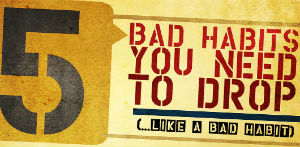5 Bad Habits that Sabotage Runners
Runners are quantitative data junkies. That's why there are a million different gadgets out there to provide us with a zillion bits of data. With so much information available to us you’d think we’d be able to avoid overtraining and injuries. There has to be a gizmo or app to protect us from ourselves, right? Unfortunately, that’s not the case.

Close to 50 percent of runners will end up with an injury this year. We keep a lot of chiropractors and orthopedics very busy! But running and injury don't have to go hand in hand. By recognizing the training pitfalls to which we are each susceptible we can help stop the cycle of injury and illness that too often derail our running.
Over Do It Syndrome | We're not made of glass, but if you pound on steel long enough, it will break, too. Tracking devices make us aware of our training speeds and distances, but the problem is that training is never linear - and all too often we try to make it so. We like to compare runs and make improvement somewhere (either in mileage or speed). But training ebbs and flows. We shouldn't go further and/or faster every time out. Doing so is a recipe for disaster. Limiting the increase in week-to-week mileage by no more than 10% is a safe way to increase training volume. In terms of adding intensity, it's not good to increase the speed of more than one run per week, whether that be a speedwork session or the pace of an easy run.
Gumby We Are Not | Running is a repetitive motion. It’s very common for us to develop inefficiencies in some areas and then overcompensate for those weaknesses in other areas. Runners love to run. What runners don’t love to do is stretch and foam roll. Often, we don’t set aside enough time to take care of our muscles. When we exercise we create micro-tears in our muscles. Our muscles respond by growing myofascia (tiny scar tissue) while the muscle rebuilds itself stronger. The stronger muscle is good, but myofascia inhibit our muscle function. The best way to avoid “runner rigor mortis” is to implement a regular stretching and foam rolling schedule.
The Hips Don't Lie | Modern lifestyles contribute to muscle weaknesses and imbalances that cause runners so many problems. We spend so much of our time sitting in a static, flexed position—which is actually the complete opposite of running. We are literally training our hips to be weak. Eight or more hours a day in a seated position leads to gluteal amnesia (i.e., our butts forget how to work). All of that sitting causes the hip abductors and external rotators to shut off. As a result, those muscles atrophy and forget how to work smoothly and in sync with the rest of the surrounding muscles. A targeted strength program can help reverse the effects of sitting. The key phrase here is a “targeted strength program.” Simply hitting the gym and knocking out squats isn’t going to help. If we have already developed muscle compensations and incorrect form, then we will do those lifts incorrectly (the compensating muscle will act in place of the muscle that should be doing an action) and make the whole issue worse.
Fashion Over Function | When I was a Fleet Feet Fit Professional, I would often explain my “Four Fs” of fitting: fit, function, and feel were my primary focus. They are like a three-legged stool: you need all three to keep from crashing. The fourth F was fashion. My wife will tell you I have no fashion sense, but if your feet are giving you the finger, what your shoes look like no longer seems that important. We need to make sure we equip ourselves with the gear that will help us stay happy and healthy. The problem is that our attention is often grabbed by the gear that is working well for someone else or receives the most stars. Get what you need. Let an expert like a Fleet Feet Fit Pro or Training Educator assist you.
Catch Some ZZZ's | About 40% of the population doesn't get the recommended 7-9 hours of sleep per night. While runners tend to handle lack of sleep better than the average person because our bodies are fitter, we also ask more from our bodies than the average person. During our deep sleep cycles our body releases human growth hormone (HGH) to rebuild and repair all of the damage we do during our training. Being short on sleep puts us behind as athletes and sets us up for injuries and illness. If you look at the amount of sleep elite athletes (in all sports) average, you'll be shocked. Our lifestyles usually don't allow us to get as much sleep as they do, but focusing on getting more quality sleep will help us stay off the injury/illness train.
The first step in fixing a problem is knowing and admitting we have one. By learning to recognize these bad habits, we can avoid the pitfalls associated with them and enjoy more productive training.
 Tim Cary is Fleet Feet's Assistant Training Manager and coach of the Fleet Feet-sponsored Runnababez Elite team. Over his more than two decades of coaching, Tim has coached athletes to three national team championships, five national individual championships, two national records, and numerous All-American and All-State honors. Click here to receive Tim's weekly article via email.
Tim Cary is Fleet Feet's Assistant Training Manager and coach of the Fleet Feet-sponsored Runnababez Elite team. Over his more than two decades of coaching, Tim has coached athletes to three national team championships, five national individual championships, two national records, and numerous All-American and All-State honors. Click here to receive Tim's weekly article via email.
Connect With Us
see the latest from Fleet Feet St. Louis